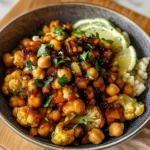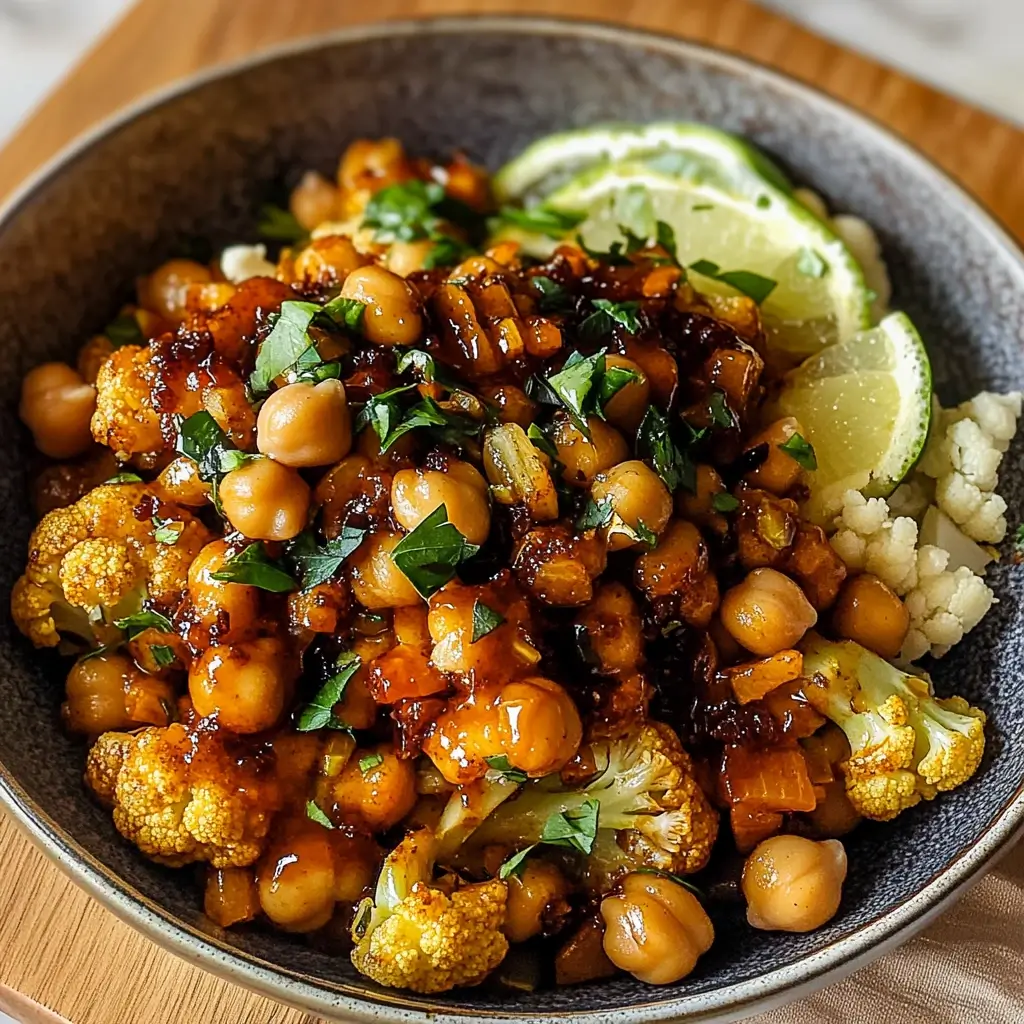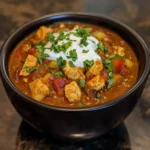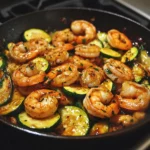Let me tell you, finding a dish that excites everyone in my family – from the spice-loving teenager to the veggie-skeptical partner – is a culinary unicorn hunt. We’ve tried countless recipes, some hits, many misses. But this Vegan Hot Honey Cauliflower and Chickpeas? This, my friends, is a resounding, unanimous HIT. The first time I made it, the aroma alone was intoxicating – a tantalizing blend of roasted cauliflower, sweet honey (vegan, of course!), and a hint of fiery spice. The vibrant colors on the plate were equally enticing, golden brown cauliflower florets nestled amongst plump, crispy chickpeas, all glistening with that irresistible hot honey glaze. And the taste? Oh, the taste! It’s a symphony of flavors and textures – the slight char and tenderness of the cauliflower, the satisfying crunch of the chickpeas, and that incredible sweet and spicy sauce that coats everything in pure deliciousness. Even my most ardent meat-eater admitted, between satisfied chews, that this was “actually really good,” which in our house is high praise indeed. This recipe has become a weeknight staple, a crowd-pleasing appetizer for gatherings, and even a delightful side dish that elevates any meal. Trust me, once you try this Vegan Hot Honey Cauliflower and Chickpeas, you’ll understand why it’s become a beloved favorite in our kitchen and why I’m so excited to share it with you. Prepare to be amazed!
Ingredients
To create this flavor explosion, you’ll need a handful of fresh, pantry-friendly ingredients. Quality ingredients are key to maximizing the taste and texture of this dish, so let’s break down what you’ll need:
- For the Cauliflower and Chickpeas:
- 1 large head of cauliflower: Choose a firm, heavy head of cauliflower, free of blemishes or discoloration. A large head will yield about 6-8 cups of florets, perfect for this recipe.
- 1 (15-ounce) can of chickpeas: Opt for low-sodium or no-salt-added chickpeas to control the salt content. Make sure to drain and rinse them thoroughly.
- 2 tablespoons olive oil: Extra virgin olive oil is recommended for its flavor and health benefits. You can also use avocado oil or another neutral cooking oil.
- 1 teaspoon smoked paprika: Smoked paprika adds a wonderful depth of flavor and smokiness that complements the sweetness and spice.
- ½ teaspoon garlic powder: Garlic powder provides a subtle garlic flavor that enhances the overall savory notes.
- ½ teaspoon onion powder: Onion powder adds a touch of sweetness and savory depth.
- ½ teaspoon salt: Adjust salt to your preference. Sea salt or kosher salt are great choices.
- ¼ teaspoon black pepper: Freshly ground black pepper is always preferred for its brighter flavor.
- For the Vegan Hot Honey Sauce:
- ¼ cup vegan butter: Use a high-quality vegan butter stick or block. Avoid spreadable tubs as they often have a higher water content. Brands like Miyoko’s Kitchen, Melt Organic, or Earth Balance are excellent options.
- ¼ cup agave nectar or maple syrup: Agave nectar provides a more honey-like sweetness, while maple syrup offers a richer, slightly caramel-like flavor. Both work wonderfully in this recipe. For a truly honey-like flavor, consider using vegan honey alternatives specifically designed to mimic honey’s taste and texture.
- 2 tablespoons apple cider vinegar: Apple cider vinegar adds a crucial tanginess that balances the sweetness and spice, creating that signature “hot honey” complexity.
- 2 tablespoons hot sauce: The type of hot sauce you choose will significantly impact the heat level and flavor profile. For a classic hot honey flavor, use a vinegar-based hot sauce like Frank’s RedHot or Crystal. For more intense heat, consider using a hotter sauce like sriracha or gochujang. Experiment to find your perfect level of spice!
- 1 tablespoon soy sauce or tamari (for gluten-free): Soy sauce or tamari adds umami and depth to the sauce. Tamari is a gluten-free alternative to soy sauce.
- 1 teaspoon red pepper flakes (optional): For an extra kick of heat, add red pepper flakes. Adjust the amount based on your spice preference.
- For Garnish (Optional):
- Sesame seeds: Toasted sesame seeds add a nutty flavor and visual appeal.
- Fresh parsley or cilantro, chopped: Fresh herbs provide brightness and freshness to balance the richness of the sauce.
- Green onions, thinly sliced: Green onions offer a mild oniony flavor and a pop of color.
Ingredient Notes and Substitutions:
- Cauliflower: You can substitute broccoli florets or a mix of cauliflower and broccoli for a variation in flavor and texture.
- Chickpeas: White beans like cannellini beans or navy beans can be used as a substitute for chickpeas. You can also use roasted edamame for a different texture.
- Vegan Butter: Coconut oil can be used as a substitute for vegan butter, but it will slightly alter the flavor profile.
- Agave or Maple Syrup: Brown rice syrup or even a date syrup can be used, but adjust sweetness to taste.
- Hot Sauce: Experiment with different hot sauces to find your preferred flavor profile. Consider using a smoky chipotle hot sauce for a smoky hot honey flavor, or a fruity habanero sauce for a sweet and fruity heat.
- Soy Sauce/Tamari: Coconut aminos can be used as a soy-free and gluten-free alternative, although it is slightly sweeter.
Instructions
Let’s get cooking! Follow these step-by-step instructions to create your delicious Vegan Hot Honey Cauliflower and Chickpeas:
- Preheat your oven and prepare the cauliflower: Preheat your oven to 400°F (200°C). While the oven is preheating, prepare the cauliflower. Wash the cauliflower head thoroughly under cold water. Remove the outer leaves and trim the stem. Cut the cauliflower head into bite-sized florets. Aim for florets that are roughly the same size to ensure even cooking. Smaller florets will cook faster and become crispier, while larger florets will remain slightly more tender.
- Season the cauliflower and chickpeas: In a large bowl, combine the cauliflower florets and drained and rinsed chickpeas. Drizzle with 2 tablespoons of olive oil. Add the smoked paprika, garlic powder, onion powder, salt, and black pepper. Toss everything together thoroughly to ensure the cauliflower and chickpeas are evenly coated with the oil and spices. Using your hands to toss can be helpful to distribute the spices evenly.
- Roast the cauliflower and chickpeas: Spread the seasoned cauliflower and chickpeas in a single layer on a large baking sheet. Avoid overcrowding the baking sheet, as this will steam the vegetables instead of roasting them. If necessary, use two baking sheets to ensure everything roasts properly. Roast in the preheated oven for 20-25 minutes, or until the cauliflower is tender-crisp and slightly golden brown, and the chickpeas are lightly crispy. Halfway through the roasting time, about 10-12 minutes in, flip the cauliflower and chickpeas using a spatula to ensure even browning on all sides. Keep an eye on them towards the end of the roasting time to prevent burning.
- Prepare the vegan hot honey sauce: While the cauliflower and chickpeas are roasting, prepare the vegan hot honey sauce. In a small saucepan, melt the vegan butter over medium heat. Once melted, add the agave nectar or maple syrup, apple cider vinegar, hot sauce, and soy sauce or tamari. If using red pepper flakes for extra heat, add them now. Whisk all the ingredients together to combine them well.
- Simmer the sauce: Bring the sauce to a gentle simmer over medium-low heat. Reduce the heat to low and let the sauce simmer for 5-7 minutes, or until it slightly thickens and the flavors meld together. Simmering helps to reduce the liquid and concentrate the flavors, creating a richer and more flavorful sauce. Stir occasionally to prevent sticking.
- Combine cauliflower, chickpeas, and sauce: Once the cauliflower and chickpeas are roasted and the sauce is ready, remove the baking sheet from the oven. Transfer the roasted cauliflower and chickpeas to a large bowl. Pour the vegan hot honey sauce over the cauliflower and chickpeas.
- Toss to coat: Gently toss the cauliflower and chickpeas with the hot honey sauce until they are evenly coated. Make sure every floret and chickpea is glistening with the sauce. You can use a large spoon or spatula to gently toss.
- Optional: Broil for extra caramelization: For an extra layer of caramelized flavor and a slightly stickier texture, you can optionally broil the coated cauliflower and chickpeas for a few minutes. Preheat your broiler to high. Spread the coated cauliflower and chickpeas back onto the baking sheet in a single layer. Broil for 2-3 minutes, watching very closely to prevent burning, until the sauce is bubbly and slightly caramelized.
- Garnish and serve: Remove from the oven and let it cool slightly. Garnish with sesame seeds, chopped fresh parsley or cilantro, and thinly sliced green onions, if desired. Serve immediately and enjoy the incredible sweet and spicy flavors!
Nutrition Facts (per serving, approximate)
- Servings: 4-6 (depending on serving size)
- Calories per serving (approximate): 250-350 calories
Approximate Nutritional Breakdown per Serving (estimated and can vary based on specific ingredients and serving size):
- Carbohydrates: 30-40 grams
- Protein: 8-10 grams
- Fat: 12-18 grams
- Fiber: 8-10 grams
- Sugar: 10-15 grams (primarily from agave/maple syrup)
Important Note: These are estimations and can vary based on the specific brands and types of ingredients used, as well as portion sizes. For more accurate nutritional information, use a nutrition calculator app and input the specific ingredients and quantities you use. This recipe is generally a good source of fiber, vitamins, and minerals from the cauliflower and chickpeas, while providing a flavorful and satisfying vegan meal option.
Preparation Time
- Prep Time: 20 minutes (chopping cauliflower, rinsing chickpeas, preparing sauce ingredients)
- Cook Time: 25-30 minutes (roasting cauliflower and chickpeas, simmering sauce)
- Total Time: 45-50 minutes
This recipe is relatively quick and easy to prepare, making it perfect for weeknight meals or when you need a delicious appetizer or side dish in under an hour. Most of the cooking time is hands-off while the cauliflower and chickpeas roast and the sauce simmers.
How to Serve
This Vegan Hot Honey Cauliflower and Chickpeas is incredibly versatile and can be served in a variety of ways:
- As a Main Course:
- Over grains: Serve it over a bed of fluffy quinoa, brown rice, couscous, or farro. The grains absorb the delicious sauce and create a complete and satisfying meal.
- With roasted vegetables: Pair it with other roasted vegetables like sweet potatoes, broccoli, Brussels sprouts, or bell peppers for a hearty and colorful vegan plate.
- In bowls: Create Buddha bowls or nourish bowls by combining the cauliflower and chickpeas with grains, greens (like spinach or kale), and other toppings like avocado, pickled onions, or toasted nuts.
- As a Side Dish:
- Alongside vegan protein: Serve it as a side dish with grilled or baked tofu, tempeh, or vegan sausages. The sweet and spicy flavors complement savory vegan proteins beautifully.
- With plant-based burgers: Elevate your veggie burger night by adding a side of hot honey cauliflower and chickpeas.
- Part of a vegan feast: Include it as a flavorful side dish in a larger vegan spread for holidays or gatherings.
- As an Appetizer:
- On its own: Serve it warm as a standalone appetizer. Provide toothpicks or small forks for easy serving.
- With dips: Offer a cooling vegan ranch dressing or a creamy avocado dip alongside for dipping.
- On crostini or crackers: Spoon the hot honey cauliflower and chickpeas onto toasted baguette slices or crackers for a sophisticated appetizer.
- In Wraps and Tacos:
- Vegan wraps: Stuff it into warm tortillas or pita bread with hummus, greens, and other veggies for a flavorful wrap.
- Vegan tacos: Use it as a filling for vegan tacos with your favorite taco toppings like salsa, guacamole, and vegan sour cream.
Additional Tips for Perfect Vegan Hot Honey Cauliflower and Chickpeas
Here are five extra tips to ensure your dish is a resounding success every time:
- Adjust the Spice Level to Your Preference: The beauty of this recipe is its adaptability. If you prefer less heat, reduce the amount of hot sauce or red pepper flakes. For a milder flavor, you can even use a mild hot sauce or skip the red pepper flakes altogether. If you love extra spice, add more hot sauce, red pepper flakes, or even a pinch of cayenne pepper to the sauce. Taste the sauce as you go and adjust the spice level to your liking.
- Don’t Overcrowd the Baking Sheet: For truly crispy cauliflower and chickpeas, ensure they are spread in a single layer on the baking sheet. Overcrowding will cause them to steam instead of roast, resulting in softer, less crispy vegetables. If necessary, use two baking sheets or roast in batches. Proper spacing allows for better air circulation and even browning.
- Toast Sesame Seeds for Enhanced Flavor: Toasted sesame seeds add a wonderful nutty flavor that complements the sweet and spicy sauce. To toast sesame seeds, simply place them in a dry skillet over medium heat and cook, stirring frequently, until they are lightly golden brown and fragrant, about 3-5 minutes. Watch them carefully as they can burn quickly.
- Add Fresh Herbs at the End for Brightness: Fresh herbs like parsley, cilantro, or green onions add a pop of freshness and brightness that balances the richness of the hot honey sauce. Chop the herbs finely and sprinkle them over the dish just before serving. This not only enhances the flavor but also adds visual appeal.
- Reheat Properly to Maintain Crispness: While best served fresh, leftovers can be reheated. To maintain some crispness, reheat in the oven or air fryer rather than the microwave. Preheat your oven or air fryer to 350°F (175°C) and reheat for 5-10 minutes, or until heated through. Microwaving can make the cauliflower and chickpeas softer.
FAQ Section
Q1: Can I make this recipe gluten-free?
A: Yes! This recipe is easily made gluten-free. Simply substitute the soy sauce with tamari, which is a gluten-free soy sauce alternative. All other ingredients in the recipe are naturally gluten-free. Always double-check the labels of your hot sauce and vegan butter to ensure they are certified gluten-free if you have a severe gluten allergy.
Q2: What if I don’t have vegan butter? Can I use something else?
A: Yes, you can substitute vegan butter with coconut oil in the hot honey sauce. However, vegan butter provides a richer, more buttery flavor that is closer to traditional hot honey sauce. Coconut oil will impart a slightly different flavor profile, with a hint of coconut. You could also try using olive oil, but the sauce will be less creamy and more liquid. For the best flavor and texture, vegan butter is highly recommended.
Q3: How spicy is this recipe?
A: The spice level of this recipe is easily adjustable. As written, it’s moderately spicy, thanks to the hot sauce and optional red pepper flakes. If you are sensitive to spice, start with a smaller amount of hot sauce (e.g., 1 tablespoon) and omit the red pepper flakes. You can always add more hot sauce to taste. Conversely, if you like it extra spicy, use a hotter hot sauce, add more red pepper flakes, or include a pinch of cayenne pepper.
Q4: Can I make this recipe ahead of time?
A: While the cauliflower and chickpeas are best served fresh and crispy, you can prepare components of this recipe in advance. You can chop the cauliflower florets and store them in an airtight container in the refrigerator for up to a day ahead. You can also prepare the vegan hot honey sauce ahead of time and store it in an airtight container in the refrigerator for up to 3 days. When ready to serve, roast the cauliflower and chickpeas, reheat the sauce, and then combine everything as instructed. For optimal crispness, it’s best to roast and sauce just before serving.
Q5: Can I use frozen cauliflower for this recipe?
A: Fresh cauliflower is highly recommended for the best texture in this recipe. Frozen cauliflower tends to release more water when roasted, which can result in a softer, less crispy texture. If you must use frozen cauliflower, make sure to thaw it completely and squeeze out as much excess water as possible before roasting. You might also need to roast it for a slightly longer time to achieve some crispness. Fresh cauliflower will yield the best results in terms of texture and flavor.
This Vegan Hot Honey Cauliflower and Chickpeas recipe is a testament to how delicious and exciting plant-based cooking can be. It’s a dish that’s sure to impress and become a regular in your recipe rotation. Enjoy the sweet heat!
Print
Vegan Hot Honey Cauliflower and Chickpeas Recipe
Ingredients
- For the Cauliflower and Chickpeas:
- 1 large head of cauliflower: Choose a firm, heavy head of cauliflower, free of blemishes or discoloration. A large head will yield about 6–8 cups of florets, perfect for this recipe.
- 1 (15-ounce) can of chickpeas: Opt for low-sodium or no-salt-added chickpeas to control the salt content. Make sure to drain and rinse them thoroughly.
- 2 tablespoons olive oil: Extra virgin olive oil is recommended for its flavor and health benefits. You can also use avocado oil or another neutral cooking oil.
- 1 teaspoon smoked paprika: Smoked paprika adds a wonderful depth of flavor and smokiness that complements the sweetness and spice.
- ½ teaspoon garlic powder: Garlic powder provides a subtle garlic flavor that enhances the overall savory notes.
- ½ teaspoon onion powder: Onion powder adds a touch of sweetness and savory depth.
- ½ teaspoon salt: Adjust salt to your preference. Sea salt or kosher salt are great choices.
- ¼ teaspoon black pepper: Freshly ground black pepper is always preferred for its brighter flavor.
- For the Vegan Hot Honey Sauce:
- ¼ cup vegan butter: Use a high-quality vegan butter stick or block. Avoid spreadable tubs as they often have a higher water content. Brands like Miyoko’s Kitchen, Melt Organic, or Earth Balance are excellent options.
- ¼ cup agave nectar or maple syrup: Agave nectar provides a more honey-like sweetness, while maple syrup offers a richer, slightly caramel-like flavor. Both work wonderfully in this recipe. For a truly honey-like flavor, consider using vegan honey alternatives specifically designed to mimic honey’s taste and texture.
- 2 tablespoons apple cider vinegar: Apple cider vinegar adds a crucial tanginess that balances the sweetness and spice, creating that signature “hot honey” complexity.
- 2 tablespoons hot sauce: The type of hot sauce you choose will significantly impact the heat level and flavor profile. For a classic hot honey flavor, use a vinegar-based hot sauce like Frank’s RedHot or Crystal. For more intense heat, consider using a hotter sauce like sriracha or gochujang. Experiment to find your perfect level of spice!
- 1 tablespoon soy sauce or tamari (for gluten-free): Soy sauce or tamari adds umami and depth to the sauce. Tamari is a gluten-free alternative to soy sauce.
- 1 teaspoon red pepper flakes (optional): For an extra kick of heat, add red pepper flakes. Adjust the amount based on your spice preference.
- For Garnish (Optional):
- Sesame seeds: Toasted sesame seeds add a nutty flavor and visual appeal.
- Fresh parsley or cilantro, chopped: Fresh herbs provide brightness and freshness to balance the richness of the sauce.
- Green onions, thinly sliced: Green onions offer a mild oniony flavor and a pop of color.
Instructions
- Preheat your oven and prepare the cauliflower: Preheat your oven to 400°F (200°C). While the oven is preheating, prepare the cauliflower. Wash the cauliflower head thoroughly under cold water. Remove the outer leaves and trim the stem. Cut the cauliflower head into bite-sized florets. Aim for florets that are roughly the same size to ensure even cooking. Smaller florets will cook faster and become crispier, while larger florets will remain slightly more tender.
- Season the cauliflower and chickpeas: In a large bowl, combine the cauliflower florets and drained and rinsed chickpeas. Drizzle with 2 tablespoons of olive oil. Add the smoked paprika, garlic powder, onion powder, salt, and black pepper. Toss everything together thoroughly to ensure the cauliflower and chickpeas are evenly coated with the oil and spices. Using your hands to toss can be helpful to distribute the spices evenly.
- Roast the cauliflower and chickpeas: Spread the seasoned cauliflower and chickpeas in a single layer on a large baking sheet. Avoid overcrowding the baking sheet, as this will steam the vegetables instead of roasting them. If necessary, use two baking sheets to ensure everything roasts properly. Roast in the preheated oven for 20-25 minutes, or until the cauliflower is tender-crisp and slightly golden brown, and the chickpeas are lightly crispy. Halfway through the roasting time, about 10-12 minutes in, flip the cauliflower and chickpeas using a spatula to ensure even browning on all sides. Keep an eye on them towards the end of the roasting time to prevent burning.
- Prepare the vegan hot honey sauce: While the cauliflower and chickpeas are roasting, prepare the vegan hot honey sauce. In a small saucepan, melt the vegan butter over medium heat. Once melted, add the agave nectar or maple syrup, apple cider vinegar, hot sauce, and soy sauce or tamari. If using red pepper flakes for extra heat, add them now. Whisk all the ingredients together to combine them well.
- Simmer the sauce: Bring the sauce to a gentle simmer over medium-low heat. Reduce the heat to low and let the sauce simmer for 5-7 minutes, or until it slightly thickens and the flavors meld together. Simmering helps to reduce the liquid and concentrate the flavors, creating a richer and more flavorful sauce. Stir occasionally to prevent sticking.
- Combine cauliflower, chickpeas, and sauce: Once the cauliflower and chickpeas are roasted and the sauce is ready, remove the baking sheet from the oven. Transfer the roasted cauliflower and chickpeas to a large bowl. Pour the vegan hot honey sauce over the cauliflower and chickpeas.
- Toss to coat: Gently toss the cauliflower and chickpeas with the hot honey sauce until they are evenly coated. Make sure every floret and chickpea is glistening with the sauce. You can use a large spoon or spatula to gently toss.
- Optional: Broil for extra caramelization: For an extra layer of caramelized flavor and a slightly stickier texture, you can optionally broil the coated cauliflower and chickpeas for a few minutes. Preheat your broiler to high. Spread the coated cauliflower and chickpeas back onto the baking sheet in a single layer. Broil for 2-3 minutes, watching very closely to prevent burning, until the sauce is bubbly and slightly caramelized.
- Garnish and serve: Remove from the oven and let it cool slightly. Garnish with sesame seeds, chopped fresh parsley or cilantro, and thinly sliced green onions, if desired. Serve immediately and enjoy the incredible sweet and spicy flavors!
Nutrition
- Serving Size: One Normal Portion
- Calories: 250-350
- Sugar: 10-15 grams
- Fat: 12-18 grams
- Carbohydrates: 30-40 grams
- Fiber: 8-10 grams
- Protein: 8-10 grams





